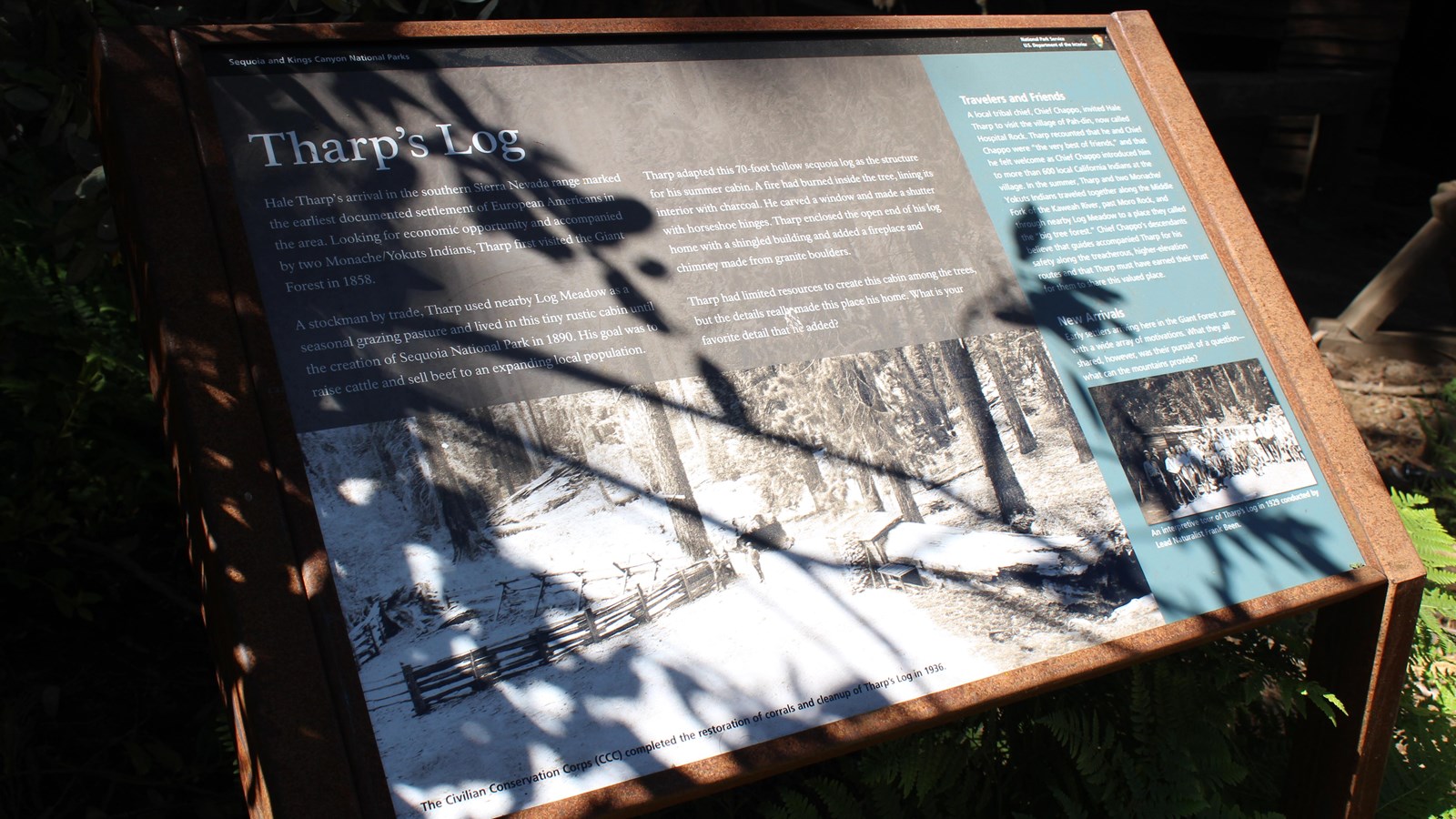Last updated: July 27, 2023
Place
"Tharp's Log" Wayside

Before you is a low-profile wayside that is 36 X 24 inches. It has two rectangular pillars supporting the panel. The panel is made from oxidized metal. The sign is located next to Tharp's Log: a historic cabin near Crescent Meadow.
Layout: The main image is a sepia-toned photograph of the cabin and corrals. The main text of the wayside blends into the top of the photograph. In a column to the right, there is text above a second, smaller, photograph.
Title: Tharp's Log
Main photo, description: a photo taken from far enough away to show the log, cabin, and corral. Two men stand next to the corral.
Photo caption: The Civilian Conservation Corps (CCC) completed the restoration of corrals and cleanup of Tharp's Log in 1936.
Main Text: Hale Tharp’s arrival in the southern Sierra Nevada range marked the earliest documented settlement of European Americans in the area. Looking for economic opportunity and accompanied by two Monache/Yokuts Indians, Tharp first visited the Giant Forest in 1858.
A stockman by trade, Tharp used nearby Log Meadow as a seasonal grazing pasture and lived in this tiny rustic cabin until the creation of Sequoia National Park in 1890. His goal was to raise cattle and sell beef to an expanding local population.
Tharp adapted this 70-foot hollow sequoia log as the structure for his summer cabin. A fire had burned inside the tree, lining its interior with charcoal. He carved a window and made a shutter with horseshoe hinges. Tharp enclosed the open end of his log home with a shingled building and added a fireplace and chimney made from granite boulders.
Tharp had limited resources to create this cabin among the trees, but the details really made this place his home. What is your favorite detail that he added?
Text, right-hand column, first section titled "Travelers and Friends": A local tribal chief, Chief Chappo, invited Hale Tharp to visit the village of Pah-din, now called Hospital Rock. Tharp recounted that he and Chief Chappo were “the very best of friends,” and that he felt welcome as Chief Chappo introduced him to more than 600 local California Indians at the village. In the summer, Tharp and two Monache/Yokuts Indians traveled together along the Middle Fork of the Kaweah River, past Moro Rock, and through nearby Log Meadow to a place they called the “big tree forest.” Chief Chappo’s descendants believe that guides accompanied Tharp for his safety along the treacherous, higher-elevation routes and that Tharp must have earned their trust for them to share this valued place.
Text, right-hand column, second section titled "New Arrivals": Early settlers arriving here in the Giant Forest came with a wide array of motivations. What they all shared, however, was their pursuit of a question—what can the mountains provide?
Right-hand column, photo description: A group of about twenty-five people in early-twentieth century dress stand in front of the cabin.
Photo caption: An interpretive tour of Tharp's Log in 1929 conducted by Lead Naturalist Frank Been.
Layout: The main image is a sepia-toned photograph of the cabin and corrals. The main text of the wayside blends into the top of the photograph. In a column to the right, there is text above a second, smaller, photograph.
Title: Tharp's Log
Main photo, description: a photo taken from far enough away to show the log, cabin, and corral. Two men stand next to the corral.
Photo caption: The Civilian Conservation Corps (CCC) completed the restoration of corrals and cleanup of Tharp's Log in 1936.
Main Text: Hale Tharp’s arrival in the southern Sierra Nevada range marked the earliest documented settlement of European Americans in the area. Looking for economic opportunity and accompanied by two Monache/Yokuts Indians, Tharp first visited the Giant Forest in 1858.
A stockman by trade, Tharp used nearby Log Meadow as a seasonal grazing pasture and lived in this tiny rustic cabin until the creation of Sequoia National Park in 1890. His goal was to raise cattle and sell beef to an expanding local population.
Tharp adapted this 70-foot hollow sequoia log as the structure for his summer cabin. A fire had burned inside the tree, lining its interior with charcoal. He carved a window and made a shutter with horseshoe hinges. Tharp enclosed the open end of his log home with a shingled building and added a fireplace and chimney made from granite boulders.
Tharp had limited resources to create this cabin among the trees, but the details really made this place his home. What is your favorite detail that he added?
Text, right-hand column, first section titled "Travelers and Friends": A local tribal chief, Chief Chappo, invited Hale Tharp to visit the village of Pah-din, now called Hospital Rock. Tharp recounted that he and Chief Chappo were “the very best of friends,” and that he felt welcome as Chief Chappo introduced him to more than 600 local California Indians at the village. In the summer, Tharp and two Monache/Yokuts Indians traveled together along the Middle Fork of the Kaweah River, past Moro Rock, and through nearby Log Meadow to a place they called the “big tree forest.” Chief Chappo’s descendants believe that guides accompanied Tharp for his safety along the treacherous, higher-elevation routes and that Tharp must have earned their trust for them to share this valued place.
Text, right-hand column, second section titled "New Arrivals": Early settlers arriving here in the Giant Forest came with a wide array of motivations. What they all shared, however, was their pursuit of a question—what can the mountains provide?
Right-hand column, photo description: A group of about twenty-five people in early-twentieth century dress stand in front of the cabin.
Photo caption: An interpretive tour of Tharp's Log in 1929 conducted by Lead Naturalist Frank Been.
